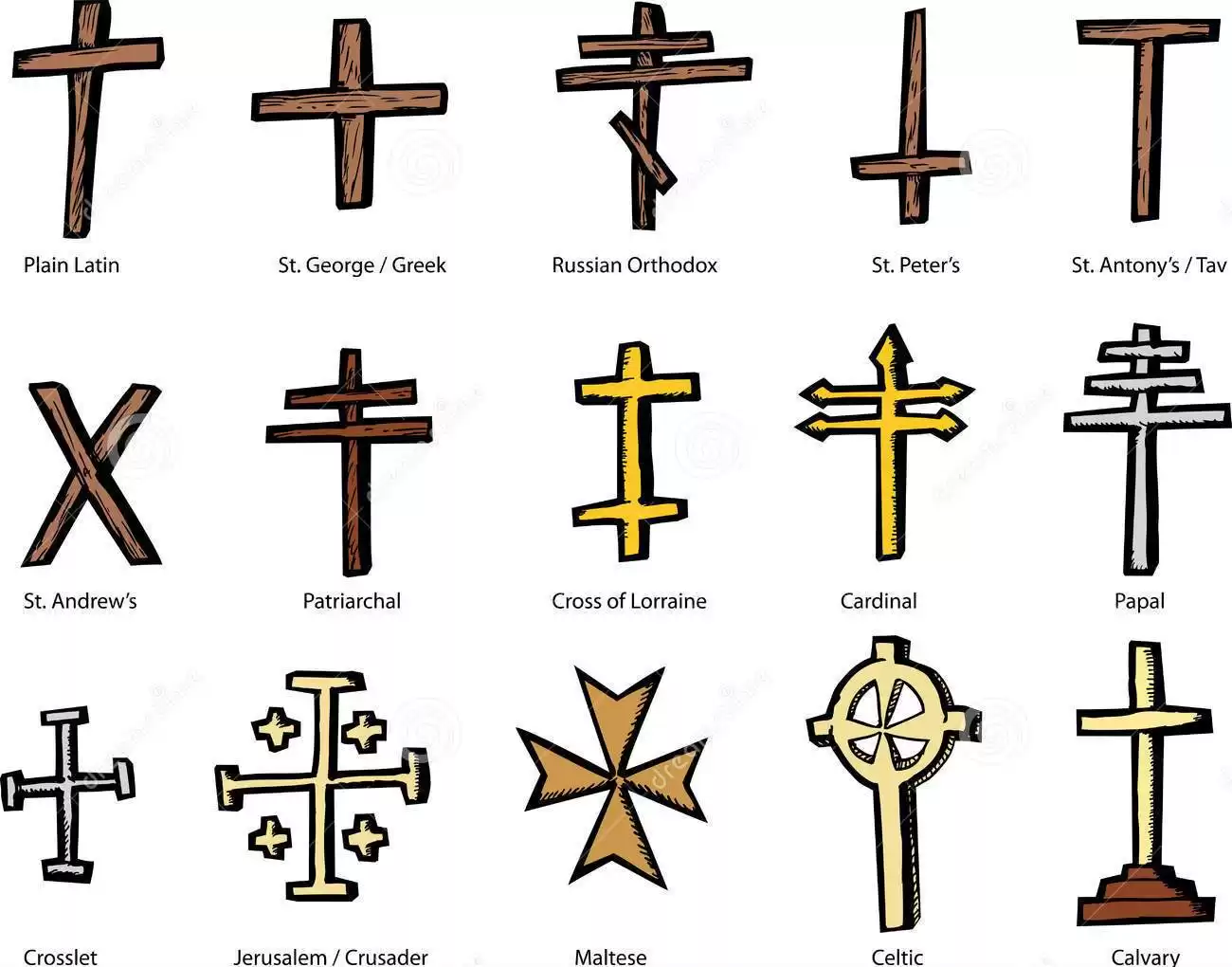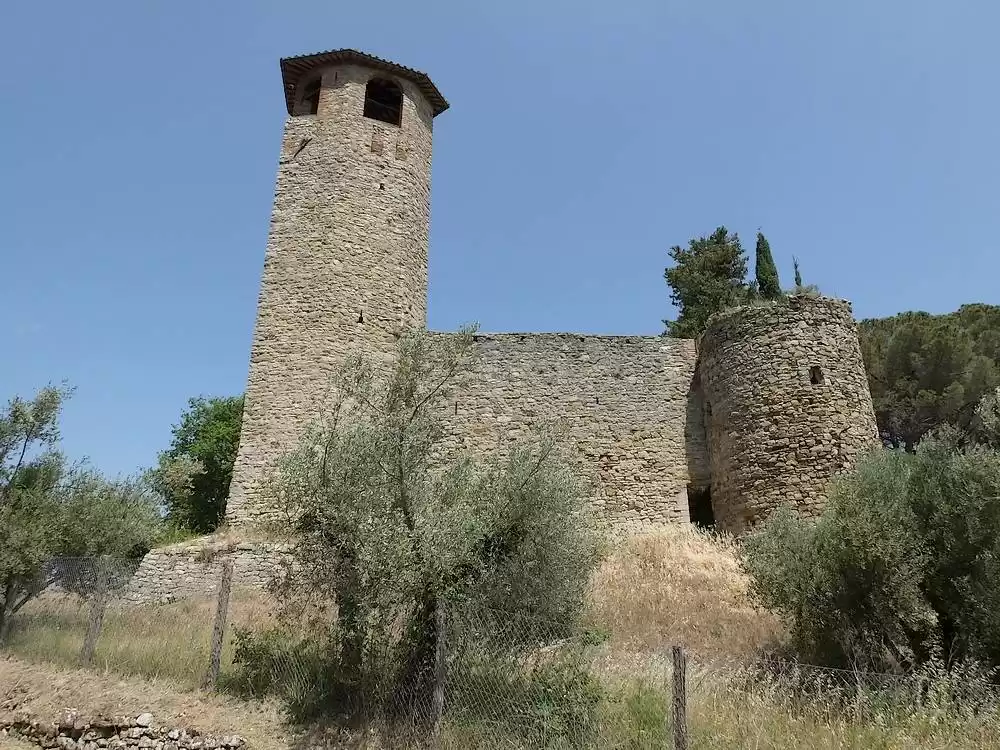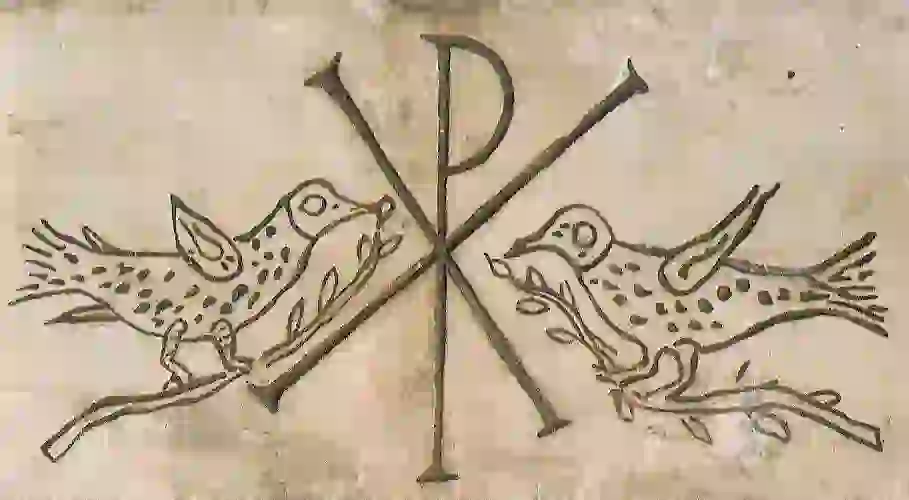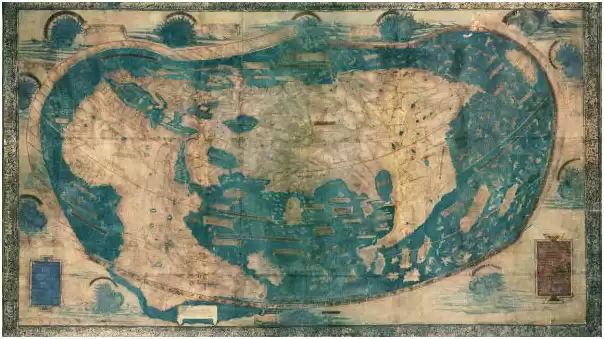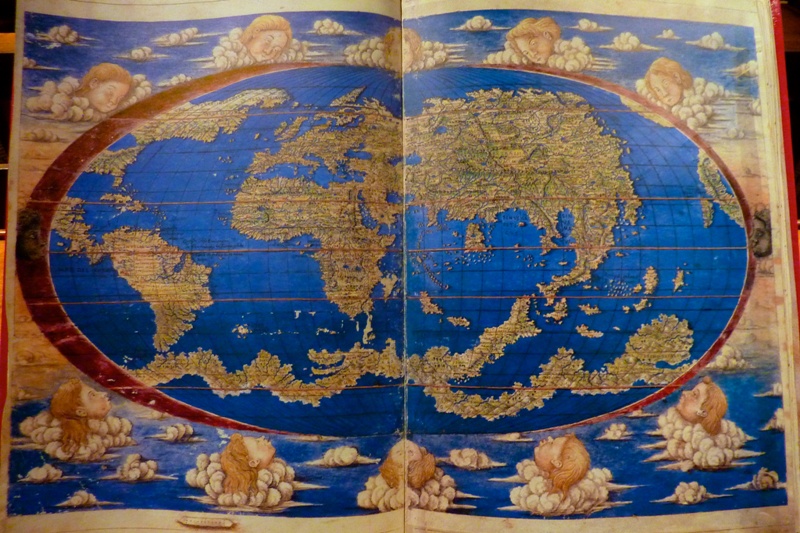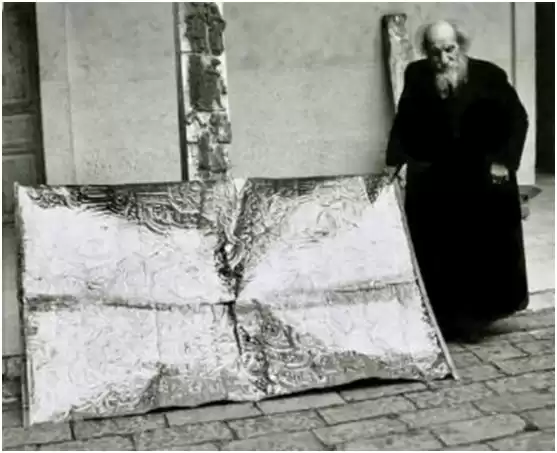Abstract
In a companion paper, Spedicato (2011), we have considered large numbers in Asian chronologies (Mesopotamia, India, Ceylon, Nepal, Japan). Such numbers are shown to get acceptable when divided by the factor 180, the same throughout the Asian continent, whose astronomic likely meaning is discussed in the paper. In this paper we consider large numbers in days, not in years, that appear in Mesoamerican Mayan and Toltec chronologies. We show how such numbers, when reduced to years under some hypotheses, provide important information for a period extending over several thousand years BC. A period that we relate to catastrophic events on our planet and to special events in the solar system.
1. Introduction
 When Europeans arrived to the American continent at the end of the 15th century and conquered in the first half of the 16th century its richest and most civilized parts, namely those corresponding to present Mexico, Guatemala and Peru, they were faced with highly developed civilizations, namely those of the Aztecs, the Mayas and the Incas. Such civilizations in addition to possessing magnificent cities had a sophisticated astronomic knowledge and had preserved in documents memory of the past, including catastrophic events. The conquering Spaniards destroyed most of these documents, being unable to understand them and attributing them to the devil. In particular we recall how bishops Diego de Landa and Nunes de la Vega ordered all documents to be collected, under death penalty, and then burned them. A small number of such documents or codices have escaped destruction and when the Mayan glyphs could be read, a recent achievement, other documents became available in tombs and inscriptions on temple walls. In Mesoamerica the documents were produced on a kind of paper made from the bark of some trees. In Peru they used the quipu system, i.e. ropes with knots and smaller ropes hanging from them. Most quipus were again destroyed, albeit a recently discovered document by Blas Valera states that the most important historic quipus were put in golden caskets and deposited on the bottom of Titicaca and another lake. They should still be there. Finding them might open a new view on the past of the south American civilization.
When Europeans arrived to the American continent at the end of the 15th century and conquered in the first half of the 16th century its richest and most civilized parts, namely those corresponding to present Mexico, Guatemala and Peru, they were faced with highly developed civilizations, namely those of the Aztecs, the Mayas and the Incas. Such civilizations in addition to possessing magnificent cities had a sophisticated astronomic knowledge and had preserved in documents memory of the past, including catastrophic events. The conquering Spaniards destroyed most of these documents, being unable to understand them and attributing them to the devil. In particular we recall how bishops Diego de Landa and Nunes de la Vega ordered all documents to be collected, under death penalty, and then burned them. A small number of such documents or codices have escaped destruction and when the Mayan glyphs could be read, a recent achievement, other documents became available in tombs and inscriptions on temple walls. In Mesoamerica the documents were produced on a kind of paper made from the bark of some trees. In Peru they used the quipu system, i.e. ropes with knots and smaller ropes hanging from them. Most quipus were again destroyed, albeit a recently discovered document by Blas Valera states that the most important historic quipus were put in golden caskets and deposited on the bottom of Titicaca and another lake. They should still be there. Finding them might open a new view on the past of the south American civilization.
In this paper we consider chronological information in the extant Mesoamerican documents. It consists of number of days, not of years as is the case in most other world ancient civilizations, e.g. the Asian ones considered in Spedicato (2011a). Once such numbers are divided by the number of days in the year (easy to do approximately, but difficult to do accurately in view of possible variations in the number of days of the year), they give quite reasonable dates. In the following we use mainly Mayan information from Gilbert and Cotterell (1996).
2. Some features of the Mayan calendar
Mayas had different calendars and different ways of grouping years. In particular they had a sacred calendar based on 260 days, called tzolkin, possibly related (Laura Laurencich Minelli, email communication) to the number of days available to agricultural activity in the tropics. We can see 260 also as the product of the numbers 20 and 13, noting that:
- number 20 is astronomically meaningful as the interval between two successive Jupiter and Saturn conjunctions; the counting systems of the Mayas was based on 20, not on 10, as has been the case for hundreds of languages worldwide, including Basque and languages in western Siberia. Number 20 was also probably the period of the planet called Nibiru by Sumerians, Metis by Greeks, that according to our proposal entered the solar system around the end of last Ice Age. It lost to Earth one of his satellites, that became our Moon, about 9450 BC. Then it impacted Jupiter about 6900 BC, leading to the Sumerian Tiamat myth. See Spedicato (2013). The real period of Nibiru was not 3600 years, as stated in Sumerian sources which followed the usual encryption in Asia multiplied it by 180, but it was actually of 20 years
- number 13 is particularly sacred for the Aztecs, see Navarro (1994), also often appearing in India, see a forthcoming monograph by Spedicato. Why 13 should be a special number may relate to the fact that in the fourth millennium BC the year had very probably13 months, implying a Moon closer to Earth from Kepler’s third law, hence more providing more light. The higher luminosity of the Moon in the past is claimed by many classic authors. A year with 13 months is suggested by about one hundred Val Camonica rock inscriptions of the fourth millennium BC, studied by scholars of the Italian Archaeo-astronomy Society, led by Giuseppe Brunod, see Brunod et al (2008). In the rock inscriptions a month is identified by a dagger, and there are 13 of such daggers for the fourth millennium BC.
 Mayas also had a standard year of 365 days. Both years were divided in months of 20 days, again a reference to the sacred character of this number, 13 months for the tzolkin and 18 for the standard year; the standard year had, at its start, an extra short period of 5 days, dedicated to prayers and festivals, a fact that we also find in ancient Egypt. Each day was identified by the names of the corresponding tzolkin and standard days, hence each day had two names. After 52 years the sequence of the two names restarted, so giving to 52 a special meaning. This period is named by scholars the aztec century. Every 52 years, but for the Aztecs even every 13 years, monuments generally were either destroyed and reconstructed or especially restored. Also Aztec kings were not allowed to be in power for over 13 years; if they were still alive after 13 years of reign, they were killed. The year was also corrected for variations due to sextile years or precession effects. One has noted that 52 is also the rather steep angle by which the great Giza pyramids rise, but this is probably just a coincidence... or not?
Mayas also had a standard year of 365 days. Both years were divided in months of 20 days, again a reference to the sacred character of this number, 13 months for the tzolkin and 18 for the standard year; the standard year had, at its start, an extra short period of 5 days, dedicated to prayers and festivals, a fact that we also find in ancient Egypt. Each day was identified by the names of the corresponding tzolkin and standard days, hence each day had two names. After 52 years the sequence of the two names restarted, so giving to 52 a special meaning. This period is named by scholars the aztec century. Every 52 years, but for the Aztecs even every 13 years, monuments generally were either destroyed and reconstructed or especially restored. Also Aztec kings were not allowed to be in power for over 13 years; if they were still alive after 13 years of reign, they were killed. The year was also corrected for variations due to sextile years or precession effects. One has noted that 52 is also the rather steep angle by which the great Giza pyramids rise, but this is probably just a coincidence... or not?
For long computations the Mayas had several time intervals, in addition to the one of 52 years,; in particular we quote the baktun consisting of 400 years of 360 days each. Especially important was the total of 13 baktuns, corresponding to 5200 years of 360 days. This period according to Joseph Goodman, see Gilbert and Cotterell (1996), started in the year 3114 BC, in a day whose double names were 4 Ahau, 8 Cumhu. We call this day the zero Mayan date. Notice that year 3114 BC corresponds, in our chronology for the Biblical Flood, to about 50 years after the Flood, that we set at 3161 BC, on arguments yet to be published. In terms of events affecting Mayas, or better the Toltec, often considered as their predecessors, it could relate either to a restart of their civilization after the Flood, or to the arrival in America, possibly from India, of some highly civilized people, bringing already established astronomic knowledge. See Appendix 2.
3. The Mayan date for birth of Venus
 In this and in the following section we consider some large numbers in days that were important for the Mayas but have never been considered of real astronomic value. They achieve an astronomic very important meaning within non standard scenarios that accept the historical values of some of the ancient human traditions and propose an evolution of the solar system of the type first considered by Velikovsky (1950), then developed by Ackerman (1996 a,b), Gillighan (2009) and this author, see Spedicato (2009, 2010, 2013).
In this and in the following section we consider some large numbers in days that were important for the Mayas but have never been considered of real astronomic value. They achieve an astronomic very important meaning within non standard scenarios that accept the historical values of some of the ancient human traditions and propose an evolution of the solar system of the type first considered by Velikovsky (1950), then developed by Ackerman (1996 a,b), Gillighan (2009) and this author, see Spedicato (2009, 2010, 2013).
The first important number, see Gilbert and Cotterell (1996), is found in the statement that 1.366.560 days passed between the birth of Venus and the zero Mayan date. To make sense of this number we use the following nonstandard scenario for the evolution of the solar system within human memory:
- Spedicato (2009), using partly information from Velikovsky’s unpublished book In the beginning, see Sammer (1999), has proposed a recent origin of the Moon as an Earth satellite at the time of Atlantis catastrophe, say about 9450 BC. In Spedicato’s model a large body passed near Earth, resulting in the Atlantis catastrophe with the rapid end of the Ice Age. This body also lost a satellite, captured by Earth, to become our Moon. Probably Earth had Mars as its previous satellite; at that time Mars was on an orbit more distant than the present Moon’s orbit, thereby looking smaller and less luminous. Mars’ orbit radius can be estimated at about one million km, from Kepler’s third law and a remarkable passage in the book De die natali, of Censorinus: the Arcadians claim, but I do not believe it, that before the Moon existed, the year had three and not twelve months
- Velikovsky (1950) claimed a recent birth of Venus, without giving a mechanism. The physicist John Ackerman (1996 a,b ) has proposed such a mechanism, namely the impact of a large body over Jupiter, in the region where the Re Spot is located, where material still pours out from a very deep crater. In our scenario of a recent origin of the Moon, it is likely that the body which passed near Earth ended its life in the giant Jupiter impact envisaged by John Ackerman. The recent discovery by probe Venus 5 that Jupiter’s core is smaller in mass than Saturn’s, a totally unexpected finding, is a dramatic confirmation of the statements in mythology, and the claims of Velikovsky and Ackerman, since an impact with a sufficiently large body can certainly expel part of the core mass of Jupiter. Notice that the mass of the impacting body has been estimated by Chinese astrophysicists in about ten time Earth mass, and we may guess that that this was the body that passed near Earth losing a satellite.
- Mars was probably still a satellite of Earth between the time of the close passage of the considered body and its impact over Jupiter, thus for a period of about 2400 years. During this period three large bodies loomed in the Earth sky, Sun, Moon, Mars, giving rise to the sacredness of number three and possibly the motivation for the theological idea of Trinity. Mars was removed probably when hit by at least a large piece of Jupiter material expelled from the core, an impact that had further important consequences not to be discussed here.
Assuming a year of 360 days, as suggested by several arguments that indicate that the year got 365 days only after the Biblical Flood, we obtain from 1.366.560 days a total of 3796 years. Using the year estimate of 365.25 days for the post Flood period we get instead about 3741 years, disregarding the possibility that Earth axis inverted three times, as suggested by some ancient statements. In this case a mathematical analysis shows that the year length would change by two days, alternating between 365 and 363 days, see Spedicato (2011b). The inversion possibility shows that passing from the number of days in the Mayan records to the number of years is a non trivial problem, probably never to be solved exactly. Incidentally notice that backwards computations of celestial movements are doomed to not provide correct results; here we consider eclipses, rising of important stars and so on.
The question is now if such a number should be counted from the starting year 3114 BC afterwards, using the year estimate of 365.25 days, or backwards, with the year estimate of 360 days. In the first case we obtain 627 AD, a date associated to the birth and expansion of Islam. But Venus was already in the sky at that time. In the second case we get 6910 BC. Such a date is acceptable within the Velikovsky-Ackerman scenario, for the following reasons:
- it corresponds to the evidence collected by Alexander and Edith Tollmann (1993), of Vienna University, a geologist and his wife paleontologist, that, around 7500 BC, a gross estimate, Earth was impacted at virtually the same time by seven bodies over oceans and continents. The bodies can be explained within the Ackerman scenario as masses expelled from the Jupiter crater, thousand km deep, formed by the impact. Recall that the Velikovsky accepted as a fact the myth of Venus being born from the head of Jupiter, a statement easily explained in the Ackerman scenario. We explain the myth in terms of a large amount of expelled material that condensed to form what evolved (Ackerman discusses the evolution stages) into present Venus. The body was initially extremely hot (being the Agni of Vedic pantheon according to Ackerman), then slowly cooled, via a sequence of states appearing as different gods in the Vedic pantheon. Circularization of the orbit took place at about the time Roman empire started, when Venus interactions with Earth ceased (as well as Mars’s). See Dixon (2002) for mathematical analysis of this circularization and De Grazia (2009) for more on the last events associated to a catastrophic Mars.
- the event took place about 1500 years before the beginning of neolithic civilization, in the sixth millennium BC; that millennium was the time of the “creation” of the seven couples of the Akkadian-Sumerian creation stories, set in the Kharsag region according to Sumerian sources, in the Garden of Eden according to Bible, which is interested in only one of the seven couples. At that time Earth was very thinly populated, after the great catastrophe ending Ice Age (and Atlantis), so the fact that the birth of Venus was memorized (albeit via non trivial interpretation of Vedic texts and Surya Siddhanta), must point out how spectacular the event was
- the fact that a meaningful precise date is provided by the Toltec-Mayas records suggests that they might be descendants of the civilization of Atlantis time, who kept for several thousand years knowledge of mathematical techniques and instruments for observing the sky. Such older civilization was centered in the Americas in the island Hispaniola, called by the local people when Columbus arrived, as Quisqueya, the mother of all lands, see Spedicato (2007 a, b). A group was probably also active in the lake Titicaca region, where the tribe of Uru, living on floating islands in the lake, claims to have been there since before the Moon existed. However the beginning date 3114 BC may be related to an input from SE Asia, as briefly discussed below
- the Mayas idea that Venus had a precisely dated birth is a very important support to the Velikovsky, and Ackerman, idea of Venus as a recent planet, albeit as far as I know they were not aware of the Mayan dating. In addition to recalling again the fast Venus birth proposed by Ackerman (1996 a,b), we notice that recent mathematical analysis of the formation of planetary bodies has shown the totally unexpected fact for mainstream astronomers that planets can form in very short times, of order a few centuries or even less. This against all previous expectations and calculations, where incomplete models and inaccurate algorithms were used, so that formation times of order tens of million years were estimated, with an error of a factor one hundred thousand!. See Meyer et al (2002).
The above scenario is to some extent hypothetical, and should be strengthened by further analysis of texts in ancient Americas and ancient India. Analysis that anyway would miss the many Indian manuscripts yet unpublished, especially and most potentially interesting those in Tamil language. Also the 6 million verses of the giant Kirghisian Manas epic should finally be made available – before they are lost with the disappearance of the Kirghisian folk singers. They may contain invaluable material, especially since the reference to Manas can be argued to relate to Noah, providing for him a different place for survival than considered before.
4. Other Mayan numbers and the length of the First Age
 In this section first we quote some very large Mayan numbers, then the duration the Mayas give to the First Age, for which we give a suitable interpretation showing that a very strict agreement exists with the standard Biblical based chronology.
In this section first we quote some very large Mayan numbers, then the duration the Mayas give to the First Age, for which we give a suitable interpretation showing that a very strict agreement exists with the standard Biblical based chronology.
The first large number is the so called long computation, equalling 136.656.000 years by using the present year value in days. This number by itself goes over several geologic ages, much beyond the about 65 million years since the Chicxulub crater impact led to the extinction of dinosaurs, as now generally accepted. It seems unbelievable that such a number originates from the human memory of some event, not to say that homo sapiens probably appeared only about 200.000 years ago. Interestingly we note that this number is an exact multiple of 180, our decrypting factor discovered for Asian numbers, see Spedicato (2011a); by dividing by 180 we get 759.200. The fact of being divisible by 180 suggests a possible origin from Asia, India especially. This is still a large number, but might be compatible with the first appearance of hominids on Earth. How to explain the origin of such a number is for me an open problem. But we may notice that one further division by 180 gives about 4218, a number very close to the duration of the ten antediluvian kings in Sumerian record or the of the ten patriarchs in the Bible, see Spedicato (2011a). A double encrypting?
Two other large numbers, found in Brennan (2003), are the following:
- The one denominated as alantun, given by 23.040.000.000 days. It corresponds according to Brennan to 63.312.328 years, on the basis of about 364 days per year. Notice that 364 days is the average value of the year between the two values 365 and 363 days of the year length before and after rotation axis inversion, see Spedicato (2011b). It is interesting to note that the Essenes used a year of 364 days. We noticed that the alantun is exactly divisible by 360, giving then 64.000.000 years. This large number is surprisingly very close to the estimated date for the impact of an asteroid over Yucatan, generating the Chixchulub crater, an impact believed to have been responsible for the disappearance of dinosaurs. If such closeness is not due to chance, explaining how Mayas could have obtained it is a task open to non standard solutions!
- The extremely large number inscribed on the so called Koba stele, corresponding to 41.341.050 sextillion years. A number of years going by far beyond the universe age. A number possibly written as a joke, or, since according to some theories universe can go through cycles of expansion and contraction, possibly related to the beginning of such a sequence of cycles. But again, wherefrom would this knowledge have come?
Another extremely important number is the one giving in 1716 years, after the usual passage from days to numbers, the duration of the so called first age, according to the Toltecs, see Allen (1998). The first age can naturally be interpreted as the one when the Mesoamerican civilization started with its zero year, corresponding to 3114 BC. Thus it can be viewed as the period between the second great Platonic catastrophe, to be associated to Noah’s Flood, and the third last catastrophe, the one of Deucalion, that can be set, see Spedicato (2010), at 1447 BC. We estimate Noah’s Flood, on reasons to be given elsewhere, at 3161 BC. Our duration for the first age is therefore 1714 years, with excellent agreement with the Toltecs estimate.
Appendix . Why 3114 BC
 Here we refer to fascinating information on the possible origin of the Toltec and Mayan civilizations, for which we are indebted to Gene D. Matlock, author of a book about Moses and Jesus in India.
Here we refer to fascinating information on the possible origin of the Toltec and Mayan civilizations, for which we are indebted to Gene D. Matlock, author of a book about Moses and Jesus in India.
In Indian ancient texts, including Fish Purana and Mahabarata, there are statements about a Flood having the features of the Noah’s Flood, including rain lasting 40 days. At least three survivors are named. One, named Satyavarman, appears to be the equivalent of Noah. One of his sons is named Iapeti (a name recalling the biblical Iaphet), another one jokes about his father sleeping drunk and not properly covered, a well known episode that Bible refers to Cam. The information about Satyavarman suggests a location for his survival in the Ark that no one has yet considered, somewhere on the mountains of India, possibly also lake Manasarovar close to the Kailash sacred mountain of Tibet. A topic to be considered elsewhere. Another survivor is called Nahusha. He is compelled to leave India, being often drunk and having raped a daughter. He crosses the ocean and reaches a small island named Sancha Dvipa, where he builds a house using seashells. Now in front of the Pacific coast of Mexico, in the province of Nayarit (whose capital is Tepic; there this author stopped after the Land Rover had an accident; a trip started at Stanford University aiming to Santa Cruz de la Sierra in Bolivia...), there is a small island, called Mexcaltitlan. This island was, according to Toltec traditions, the entry point in Mexico of Quetzalcoatl. Before the arrival of the Spaniards, people there used to build houses with seashells.
If the story is true and Mexcaltitlan was the entry point of Nahusha remembered as Quetzalcoatl, then it is quite likely that this man brought to America knowledge from India, where an advanced civilization has existed during at least one thousand years before the Flood, partly described in the epics of Ramayana and Mahabharata. And 3114 BC was a date, some fifty years after the 3161 BC Flood, associated to a special event and one certainly to be remembered.
References
J. Ackerman, Firmament, in www.firmament-chaos.com, 1996
J. Ackerman, Chaos, in www.firmament-chaos.com, 1996
M. Brennan, Il segreto dei Maya, Newton Compton, 2003
G. Brunod, M. Cinquetti, A. Pia, G. Veneziano, Un calendario per gli uomini dell’età del rame. un antico osservatorio astronomico. Paspardo, capitello dei due pini, roccia del sole, Print Broker, 2008
A. De Grazia, The iron age of Mars, Metron, 2009
A. Gilbert and M. Cotterell, Le profezie dei Maya, Corbaccio, 1996
G. Gillighan, Comet Venus, Matador, 2009
L. Meyer, T. Quinn, J. Wadsley and J. Stadel, Formation of great planets by fragmentation of protoplanetary disks, Science 298, 1756-1759, 2002
R. L. Navarro, El numero 13 en la vida de los Aztecas, Costa-Amic Editores, 1994
Z. Sitchin, Il Dodicesimo Pianeta, Edizioni Mediterranee, 1996
Spedicato E., Eden revisited : geography, numerics and other tales, Migration and Diffusion 4, 16, 2003
E. Spedicato, Atlantis in Quisqueya 1. The Atlantis destruction, part I: catastrophic end of the last Ice Age by extraterrestrial agents, Proceedings of the International Conference on The Atlantis Hypothesis: Searching for a Lost Land, Milos island, July 2005, S. Papamarinopoulos ed., Heliotopos, 389-404, 2007a
E. Spedicato, Atlantis in Quisqueya 2.The Atlantis destruction, part II: interpretation of the Platonic story and Atlantis in Hispaniola, Proceedings of the International Conference on The Atlantis Hypothesis: Searching for a Lost Land, Milos island, July 2005, S. Papamarinopoulos ed., Heliotopos,405-416, 2007b
E. Spedicato, On the recent origin of the Moon: a four-five body scenario for a capture event and its mathematical modeling via nonlinear optimization, in SIS Special Volume devoted to Alfred De Grazia on Occasion of his 90th Birthday, Ian Tresman editor, 2009
E. Spedicato (2010), Atlantide e l’Esodo, Platone e Mosè avevano ragione, Aracne. 2010
E. Spedicato, Grandi numeri nelle cronologie asiatiche: una chiave di lettura, Quaderni Asiatici 93, 93-112, 2011a
E. Spedicato, On the reversal of the rotational momentum of Earth: a derivation and analysis of the Herodotus equation, in Astronomia culturale in Italia, SIA, Elio Antonello editor, 89-98, 2011b
E. Spedicato, From Nibiru to Tiamat, an astronomic scenario for earliest Sumerian cosmology, International Russian-American Scientific Journal "Actual problems of aviation and aerospace systems", Kazan-Daytona Beach,18, 25-35, 2013
A. Tollmann and E. Tollmann, Und die sintflut gab es doch, von Mythos zur historischen Warheit, Droemer Knaur, 1993
I. Velikovsky, Worlds in Collision, Doubleday, 1950

